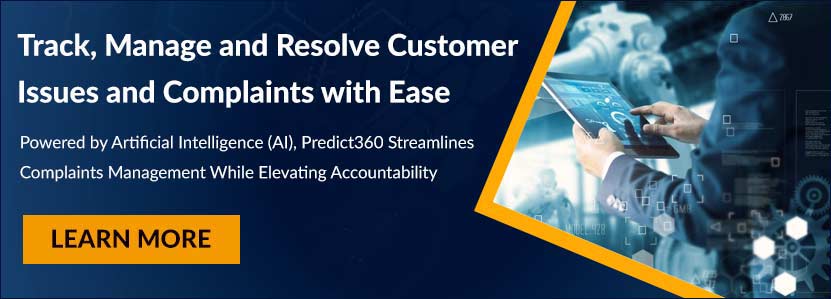Home/ Blog / How Complaints Can Provide Insights for Risk and Compliance Managers
Complaints have always been important for businesses. Managing complaints properly is critical for several reasons. The most obvious reason is that it is a core function of customer service to ensure those customer complaints are dealt with. However, most organizations utilize complaint data for much more than just replying to the complainants. This data can highlight problems in service delivery, which helps the organization improve its processes. Increased synergy in financial organizations is enabling risk and compliance managers to go one step ahead and leverage complaint data for insights and predictions for their domains.

Breaking Complaint Data Out of the Silo
The creation of silos is a common problem in organizations. Departments often have data that can be helpful to other departments, but the data is not shared with the rest of the organization. Silos within an organization can be so rigid that often other departments do not even know that a department already has the data they need. Complaints are often siloed similarly. Complaints are handled by teams responsible for customer service and are then provided to the compliance team to let them know about any non-compliance that may have occurred. The risk and compliance teams might not even have access to complain data because they do not use the platform/technology being used to handle complaints.
Breaking the silo would mean that complaint data is shared with the rest of the organization. While this is possible to do manually, a much better approach would be to use the same platform to manage complaints that are being used to manage risk and compliance throughout the organization.
Integrating complaint management with risk and compliance management doesn’t just benefit-risk and compliance – it also significantly improves the organization’s ability to resolve complaints. Share on XComplaints as a Leading Indicator
Financial organizations should focus on complaints because it is a useful leading indicator for both risk and compliance. Making complaint data visible to risk and compliance teams alerts them to problematic developments that need to be mitigated. A higher than a usual number of complaints from a business unit may signify either a compliance failure or an increased risk that the financial organization has not recognized. Similarly, comparing historical complaint data to current complaint data enables risk and compliance managers to prioritize their activities where they are needed the most.
Most organizations have a team dedicated to dealing with customer complaints. While dealing with existing complaints might be the responsibility of the complaint management team, it is the responsibility of the risk and compliance teams to minimize complaints. Complaints can be minimized by ensuring that the SOPs in every business unit includes the necessary controls for both risk and compliance.
Data from complaints is already used by both risk and compliance team in their reporting. The risk team needs to assess the risks associated with the complaints. The compliance team looks at the number of compliance violations that resulted in the complaints. However, integrating complaint data directly into the risk and compliance framework of the organization makes the data available in real-time. Risk and compliance teams can slice and dice the data for analysis and connect the results with risk and compliance metrics. The integration empowers the risk and compliance teams by giving them access to leading indicators and metrics. The increased accessibility of data means that both teams can generate more insights and provide actionable business intelligence to the board of directors.
Enhanced Complaint Mitigation
Integrating complaint management with risk and compliance management doesn’t just benefit-risk and compliance – it also significantly improves the organization’s ability to resolve complaints. Using the same platform to manage complaints, risk, and compliance means that risk and compliance experts are always available on the platform when needed. There can often be delays in complaint resolution if the complaint management team requires the cooperation of the risk or compliance teams to resolve a complaint. Usually, the complaint team sends out an email, and further details are discussed in meetings.
Unifying the platform on which risk, compliance, and complaint teams work means that the complaint team has to tag the relevant stakeholder in a complaint. The stakeholder from the risk or compliance team will be able to look at all the complaint details on the same platform. There is no need to create email chains with reports and data that go back and forth – all the communication and information are handled on the same platform. What’s more, the progression of each task is also being tracked by the platform. Management can quickly see how many complaints there are, what stage they are in, and much more from dashboards.
Increased integration results in enhanced insights and better predictions for risk and compliance. Interested in seeing how your organization can integrate complaints into the risk and compliance framework? Get in touch with our experts for a demonstration of Predict360, our American Bankers Association (ABA) endorsed risk and compliance solution.
Request a Demo
Complete the form below and our business team will be in touch to schedule a product demo.
By clicking ‘SUBMIT’ you agree to our Privacy Policy.




